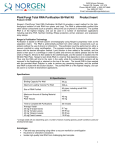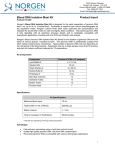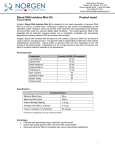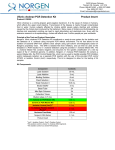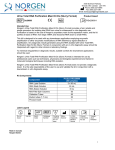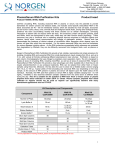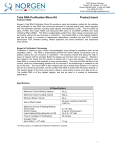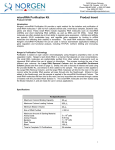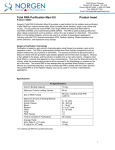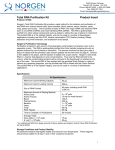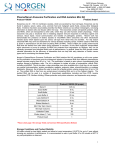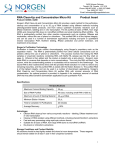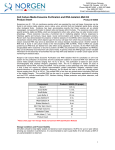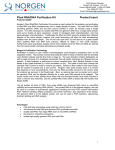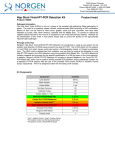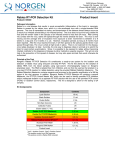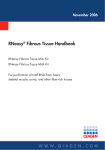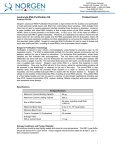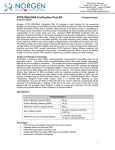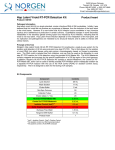Download Protocol (25 prep) - Norgen Biotek Corp.
Transcript
3430 Schmon Parkway Thorold, ON, Canada L2V 4Y6 Phone: 866-667-4362 (905) 227-8848 Fax: (905) 227-1061 Email: [email protected] Plant microRNA Purification Kit Product Insert Product # 54700 Introduction Norgen’s Plant microRNA Purification Kit provides a rapid method for the isolation and purification of small RNA molecules (< 200 nt) from cultured plant cells or plant tissues. These small RNAs include regulatory RNA molecules such as microRNA (miRNA) and short interfering RNA (siRNA), as well as tRNA and 5S rRNA. Small RNA molecules are often studied due to their ability to regulate gene expression. miRNAs and siRNAs are typically 20-25 nucleotides long, and regulate gene expression by binding to mRNA molecules and affecting their stability or translation. The small RNA molecules isolated using Norgen’s Plant microRNA Purification Kit can be used in various downstream applications relating to gene regulation and functional analysis, including RT-PCR, miRNA sequencing, northern blotting and microarray analysis. Norgen’s Purification Technology Purification is based on spin column chromatography using Norgen’s proprietary resin as the separation matrix. Norgen’s resin binds RNA in a manner that depends on ionic concentrations. The small RNA molecules are preferentially purified from other cellular components such as ribosomal RNA without the use of phenol or chloroform. The process involves the use of two different spin columns: the Large RNA Removal Column and the microRNA Enrichment Column (please see flow chart on page 3). Briefly, the cells or tissues of interest are lysed using the provided Lysis Buffer C, the lysate is spun through the provided the Filter Column, and then ethanol is added to the clarified lysate. The lysate is then applied to the Large RNA Removal Column, and the larger RNA molecules will bind to the resin in the spin column while the smaller RNA species will pass through into the flowthrough. Ethanol is then added to the flowthrough, and the sample is applied to the microRNA Enrichment Column. The small RNA molecules will then bind to the resin, and any impurities are removed through a series of washes with the provided Wash Solution A. The small RNA molecules are then eluted using the Elution Solution, and are ready for use in various applications. Specifications Kit Specifications Maximum Column Binding Capacity 50 g Maximum Column Loading Volume 650 L Minimum Elution Volume 20 L Size of RNA Purified < 200 nt Amount of Starting Material: Plant Tissues 100 mg 6 5 x 10 cells Time to Complete 10 Purifications 25 minutes Advantages Fast and easy processing using a rapid spin-column format No phenol or chloroform extractions Isolate all small RNA molecules (<200 nt) Minimal contamination from large RNA molecules and genomic DNA High quality small RNA can be used in various downstream applications 1 Kit Components Component Lysis Buffer C Wash Solution A Elution Solution A Filter Columns Large RNA Removal Columns microRNA Enrichment Columns Collection Tubes Elution tubes (1.7 mL) Product Insert Product # 54700 (25 preps) 30 mL 18 mL 6 mL 25 25 25 50 50 1 Storage Conditions and Product Stability All solutions should be kept tightly sealed and stored at room temperature. should remain stable for at least 1 year in their unopened containers. These reagents Precautions and Disclaimers This kit is designed for research purposes only. It is not intended for human or diagnostic use. Ensure that a suitable lab coat, disposable gloves and protective goggles are worn when working with chemicals. For more information, please consult the appropriate Material Safety Data Sheets (MSDSs). These are available as convenient PDF files online at www.norgenbiotek.com. The Lysis Buffer C contains guanidinium salts, and should be handled with care. Guanidinium salts form highly reactive compounds when combined with bleach, thus care must be taken to properly dispose of any of these solutions Customer-Supplied Reagents and Equipment Benchtop microcentrifuge 96 - 100% ethanol RNase-free microcentrifuge tubes Liquid nitrogen Mortar and pestle Working with RNA RNases are very stable and robust enzymes that degrade RNA. Autoclaving solutions and glassware is not always sufficient to actively remove these enzymes. The first step when preparing to work with RNA is to create an RNase-free environment. The following precautions are recommended as your best defense against these enzymes. The RNA area should be located away from microbiological work stations Clean, disposable gloves should be worn at all times when handling reagents, samples, pipettes, disposable tubes, etc. It is recommended that gloves are changed frequently to avoid contamination There should be designated solutions, tips, tubes, lab coats, pipettes, etc. for RNA only All RNA solutions should be prepared using at least 0.05% DEPC-treated autoclaved water or molecular biology grade nuclease-free water Clean all surfaces with commercially available RNase decontamination solutions When working with purified RNA samples, ensure that they remain on ice during downstream applications 2 Flow Chart Procedure for Purifying Small RNA Molecules using Norgen’s Plant microRNA Purification Kit Lyse cells or tissue using Lysis Buffer C Transfer to Filter Column SPIN Add ethanol. Bind large RNA molecules to Large RNA Removal Column SPIN Retain Flowthrough Add ethanol to flowthrough Bind small RNA molecules from flowthrough onto microRNA Enrichment Column SPIN Wash three times with Wash Solution A SPIN Elute small RNA with Elution Solution A Purified Small RNA (miRNA, siRNA, tRNA, 5S rRNA, etc) 3 Procedures All centrifugation steps are carried out in a benchtop microcentrifuge. Various speeds are required for different steps, so please check your microcentrifuge specifications to ensure that it is capable of the proper speeds. All centrifugation steps are performed at room temperature. The correct rpm can be calculated using the formula: RPM = RCF (1.118 x 10-5) (r) where RCF = required gravitational acceleration (relative centrifugal force in units of g); r = radius of the rotor in cm; and RPM = the number of revolutions per minute required to achieve the necessary g-force. Section 1. Preparation of Lysate from Various Cell Types All centrifugation steps are carried out in a benchtop microcentrifuge at 14,000 x g (~14,000 RPM) except where noted. All centrifugation steps are performed at room temperature. Notes Prior to Use 1. A variable speed centrifuge should be used for maximum kit performance. If a variable speed centrifuge is not available a fixed speed centrifuge can be used, however reduced yields may be observed. Ensure that all solutions are at room temperature prior to use. There are 2 different spin columns provided with this kit; the Large RNA Removal Column and the microRNA Enrichment Column. Ensure that the correct column is used for each step of the procedure. Prepare a working concentration of the Wash Solution A by adding 42 mL of 96 – 100 % ethanol (provided by the user) to the supplied bottle containing the concentrated Wash Solution. This will give a final volume of 60 mL. The label on the bottle has a box that may be checked to indicate that the ethanol has been added. 7 The recommended input is 100 mg of plant tissue or 5 x 10 cells. However it can be reduced (to 30 mg) or increased (up to 150 mg) depending on customer’s optimization based on a sample type. Both fresh and frozen plant tissues can be used for this protocol. Samples should be flash-frozen in liquid nitrogen and transferred immediately to a -70°C freezer for long-term storage. Do not allow frozen tissues to thaw prior to grinding with the mortar and pestle in order to ensure that the integrity of the RNA is not compromised. It is important to work quickly during this procedure. Cell Lysate Preparation 7 a. Transfer ≤100 mg of plant tissue or 5 x 10 plant cells (see Notes Prior to Use) into a mortar that contains an appropriate amount of liquid nitrogen to cover the sample. Grind the sample into a fine powder using a pestle in liquid nitrogen. Note: If stored frozen samples are used, do not allow the samples to thaw before transferring to the liquid nitrogen. b. c. d. e. f. Allow the liquid nitrogen to evaporate, without allowing the tissue to thaw. Transfer the powder to a 1.5 mL centrifuge tube (not provided) Add 600 L of Lysis Buffer C and vortex vigorously for 30 seconds. Assemble a Filter Column (clear O-ring) with one of the provided collection tubes. Pipette the lysate into the Filter Column and spin for 2 minutes at 14,000 x g (~14,000 RPM). 4 g. Transfer only the clear supernatant from the flow-through into a RNAase-free microcentrifuge tube (not provided) using a pipette. Note the volume of the supernatant/lysate. Note: Ensure that only the clear supernatant is transferred, avoiding any of the debris at the bottom of the collection tube. h. Add a volume of 96-100% ethanol (provided by the user) that is a half of the lysate volume (50 L of ethanol is added to every 100 L of lysate). Vortex to mix. Proceed to Step 2. 2. Large RNA Removal a. Retrieve a Large RNA Removal Column assembled with a collection tube. b. Apply the lysate with the ethanol (from step 1) onto the column and centrifuge for 1 minute. Retain the flowthrough, which contains the small RNA species. If small RNA-depleted RNA is to be isolated, retain the column and proceed to the Optional Large RNA Purification Protocol (Appendix A). Otherwise, discard the column. Note: The flowthrough contains the small RNA, thus ensure that this fraction is not discarded. 3. Small RNA Capture a. Add 1 volume of 96 – 100% ethanol (provided by the user) to the flowthrough collected in Step 2b (100 L of ethanol is added to every 100 L of flowthrough). Mix by vortexing for 10 seconds. b. Assemble a microRNA Enrichment Column with one of the provided collection tubes. c. Apply half of the lysate mix with ethanol onto the column and centrifuge for 1 minute. d. Discard the flowthrough and reassemble the spin column with the collection tube. e. Repeat steps 3c and 3d to complete the capture of the small RNA. 4. Column Wash a. Apply 400 μL of Wash Solution A to the microRNA Enrichment Column and centrifuge for 1 minute. Note: Ensure the entire wash solution has passed through into the collection tube by inspecting the column. If the entire wash volume has not passed, spin for an additional minute. b. Discard the flowthrough and reassemble the spin column with the collection tube. c. Repeat steps 4a and 4b to wash column a second time. d. Wash column a third time by adding another 400 L of Wash Solution A and centrifuging for 1 minute. e. Discard the flowthrough and reassemble the spin column with its collection tube. f. Spin the column for 2 minutes in order to thoroughly dry the resin. Discard the collection tube. 5. Small RNA Elution a. Place the microRNA Enrichment Column into a fresh 1.7 mL Elution tube provided with the kit. b. Add 20 L of Elution Solution A to the column. 5 c. Centrifuge for 2 minutes at 200 x g (~2,000 RPM), followed by 1 minute at 14,000 x g (~14,000 RPM) Note the volume eluted from the column. If the entire volume has not been eluted, spin the column at 14,000 x g (~14,000 RPM) for 1 additional minute. Note: 6. For maximum RNA recovery, it is recommended that a second elution be performed into a separate microcentrifuge tube (Repeat Steps 5b and 5c). Storage of RNA The purified RNA sample may be stored at –20°C for a few days. samples be placed at –70°C for long term storage. Appendix A: 1. It is recommended that Optional Large RNA Purification Protocol Column Wash a. b. Reassemble the Large RNA Removal Column with the collection tube used in Step 2b Apply 400 L of Wash Solution A to the Large RNA Removal Column and centrifuge for 1 minute. Note: Ensure that the entire Wash Solution has passed through into the collection tube by inspecting the column. If the entire wash volume has not passed, spin for an additional minute. c. Discard the flowthrough and reassemble the spin column with the collection tube. d. Repeat steps 1b and 1c to wash the column a second time. e. Wash column a third time by adding another 400 L of Wash Solution A and centrifuging for 1 minute. f. Discard the flowthrough and reassemble the spin column with its collection tube. g. Spin the column for 2 minutes in order to thoroughly dry the resin. Discard the collection tube. 2. Large RNA Elution a. Place the Large RNA Removal Column into a fresh 1.7 mL Elution tube provided with the kit. b. Add 50 L of Elution Solution A to the column. c. Centrifuge for 2 minutes at 200 x g (~2,000 RPM), followed by 1 minute at 14,000 x g (~14,000 RPM). Note the volume eluted from the column. If the entire volume has not been eluted, spin the column at 14,000 x g (~14,000 RPM) for 1 additional minute. Note: 3. For maximum RNA recovery, it is recommended that a second elution be performed into a separate microcentrifuge tube (Repeat Steps 2b and 2c). Storage of RNA The purified RNA sample may be stored at –20°C for a few days. samples be placed at –70°C for long term storage. It is recommended that 6 Troubleshooting Guide Problem Possible Cause Solution and Explanation Incomplete lysis of cells or tissue Ensure that the appropriate homogenization step and amount of Lysis Buffer C was used for the amount of cells or tissue. Incubate the sample with the Lysis Buffer C at 55˚C for 5 minutes. Large RNA Removal Column has become clogged Do not exceed the recommended amounts of starting materials. The amount of starting material may need to be decreased if the column shows clogging below the recommended levels. See also “Clogged Column” below. An alternative elution solution was used It is recommended that the Elution Solution A supplied with this kit be used for maximum RNA recovery. Low RNA content Different tissues and cells have different RNA contents. Some tissues may not contain small RNA at detectable levels when processing the small sample sizes required for this procedure. Flowthrough from the first binding step was discarded The flowthrough from the binding step with the Large RNA Removal Column contains the small RNA molecules, thus ensure that it is not inadvertently discarded. Ethanol was not added to the flowthrough before binding to the microRNA Enrichment Column Ensure that the appropriate amount of ethanol was added to the flowthrough from the first binding step before it is applied to the microRNA Enrichment Column. This is imperative in order to capture the small RNA molecules. Ethanol was not added to the Wash Solution Ensure that 42 mL of 96 – 100 % ethanol is added to the supplied Wash Solution A prior to use. Poor RNA Recovery 7 Problem Clogged Column RNA is Degraded RNA does not perform well in downstream applications Possible Cause Solution and Explanation Insufficient solubilization of cells or tissues Ensure that the appropriate amount of Lysis Buffer C was used for the amount of cells or tissue. Maximum number of cells or amount of tissue exceeds kit specifications Refer to specifications to determine if amount of starting material falls within kit specifications. Centrifuge temperature too low Ensure that the centrifuge remains at room temperature throughout the procedure. Temperatures below 15°C may cause precipitates to form that can cause the columns to clog. RNase contamination RNases may be introduced during the use of the kit. Ensure proper procedures are followed when working with RNA. Please refer to “Working with RNA” at the beginning of this user guide. Procedure not performed quickly enough In order to maintain the integrity of the RNA, it is important that the procedure be performed quickly. Improper storage of the purified RNA For short term storage RNA samples may be stored at –20°C for a few days. It is recommended that samples be stored at –70°C for longer term storage. Frozen tissues or pellets were allowed to thaw prior to disruption Tissue samples should be flash-frozen in liquid nitrogen and transferred immediately to a -70°C freezer for longterm storage. Do not allow frozen tissues to thaw prior to grinding with the mortar and pestle in order to ensure that the integrity of the RNA is not compromised. RNA was not washed three times with the provided Wash Solution Traces of salt from the binding step may remain in the sample if the microRNA Enrichment Column is not washed three times with Wash Solution A. Salt may interfere with downstream applications, and thus must be washed from the column. Ethanol carryover Ensure that the dry spin under the Column Wash procedure is performed, in order to remove traces of ethanol prior to elution. Ethanol is known to interfere with many downstream applications. 8 Problem Genomic DNA contamination Possible Cause Solution and Explanation Large amount of starting material used Perform RNase-free DNaseI digestion on the RNA sample after elution to remove genomic DNA contamination. Improper amount of ethanol added to the lysate before binding to the Large RNA Removal Column Ensure that the appropriate amount of ethanol was added to the lysate before it is applied to the Large RNA Removal Column. This is imperative in order to capture the large RNA molecules onto the column. Large amount of starting material used Repeat purification using less starting material. Alternatively, the isolation procedure can be repeated using the elution as the input. The elution volume should first be adjusted to 300 L using the provided Lysis Solution. The procedure can then be followed as written in the manual, starting with the addition of ethanol, centrifuging the lysate in order to pellet any debris, and applying the clarified lysate to the Large RNA Removal Column. Repeating the procedure should result in the removal of the large, contaminating RNA species. Large RNA species present in elution Related Products 100b RNA Ladder 1kb RNA Ladder Plant/Fungi Total RNA Purification kit Plant RNA/DNA Purification Kit Product # 15002 15003 25800, 31350, 31900 24400 Technical Support Contact our Technical Support Team between the hours of 8:30 and 5:30 (Eastern Standard Time) at (905) 227-8848 or Toll Free at 1-866-667-4362. Technical support can also be obtained from our website (www.norgenbiotek.com) or through email at [email protected]. 3430 Schmon Parkway, Thorold, ON Canada L2V 4Y6 Phone: (905) 227-8848 Fax: (905) 227-1061 Toll Free in North America: 1-866-667-4362 © 2014 Norgen Biotek Corp. PI54700-3-M14 9









